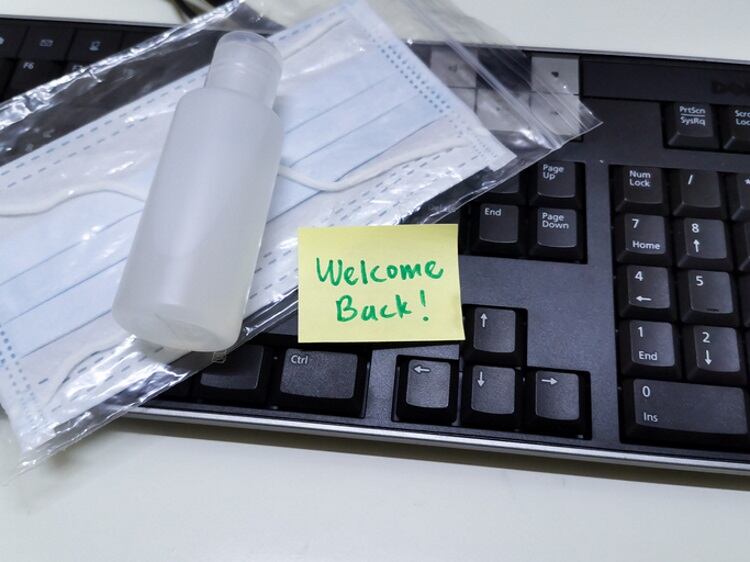
As the phased return to normality is likely to be rolled out over a few months, employers are going to have different needs and requirements in how to restart operations.
The timescale by which they can do so, will depend on the industry they are in. Similarly, employees will have their own considerations and mixed feelings about returning to work with childcare, transportation and health concerns, front of mind.
In some cases, employers and employees may wish to remain working at home for productivity and to enable social distancing for an extended period.
Each employer’s management of this will need to take into account its operational needs, together with the law and government guidance on how employees can return to work safely.
Can an employee be forced to return to work? What if they are not comfortable to do so? On what basis can they refuse to go to work?
The Government has recently advised people to go back to work only if they cannot work from home. This may change again with updated announcements.
Employers should realistically undertake a Covid-19 specific risk assessment in respect of their employees returning to work.
Employers do have a legal health and safety obligation, so they must ensure they are operating effective social distancing measures within the workplace. If they have not, employees have a right not to attend their workplace if there is a reasonable belief that doing so would pose a ‘serious and imminent threat’. If an employee decides to not go back to work for this reason, they can put in a grievance at work to protect their employment rights and help to stop an unfair dismissal.
The business needs versus safety will be governed by the risk assessment, but staff must be treated fair and non-discriminatory and we strongly advise that staff are consulted and discussions take place as to their needs to avoid claims and also to motivate staff.
If you are still home-schooling or have no child care options, on what basis can you request flexible working or remain at home working?
Some workplaces will offer flexibility and on-going home working to their employees, so the first port of call should be a discussion between staff and their line manager to try and come to an arrangement.
Employees who have been employed for more than 26 weeks may request flexible working arrangements with their employers. This is a statutory right and the employer must deal with the request in a reasonable timeframe. There may be greater need for flexible working so that you can cover childcare or home schooling, and since the government has suggested varying start/finish times in the phased return to work, it is a practical and sensible solution for both employee and employer.
Requests must be given due consideration and an employer cannot discriminate when giving a decision, but ordinarily it is not duty bound to agree to this. However, these are not normal circumstances, so how the Tribunals may view these cases as they come through will be enlightening. More information is available on the government’s website.
While it may have appeared the current remote working conditions are a temporary fix to help businesses continue operations during the outbreak and that they will eventually get back to standard working practice, it is likely some employees will want to continue working remotely. It is also likely employers will wish for staff to remain doing so to help with the staggered return to work plan or for it to reduce office space requirements.
Consultations can take place about how remote working could continue, for how long and for whom, but employers need to be careful to offer this to staff in a non-discriminatory way that is perceived as fair to all staff. Employers also need to ensure they have updated work at home and have GDPR and health assessment policies in place.
Furlough
The scheme requires employees to be furloughed for a minimum of three weeks. If an employer wants to extend the period, they will need staff consent to vary the agreement.
From August, the furlough scheme will allow employers to bring back employees on a part-time basis to aid in the transition to normal working life. This may allow skill levels to be kept high and also help with child arrangements, but will still require a consent.
Usually staff policies or handbooks are outside the employment contract. These can be amended without consent and simply communicated, so staff should be informed, as they will be obliged to follow these procedures.
Motivating staff during furlough, as well as those continuing to work, should be a key consideration for any employer that wants its team to pull together post pandemic.
With a huge number of employees being furloughed across the UK – more than the Government anticipated – businesses will need to be aware that reintroducing those members of staff who were furloughed may feel out of touch.
Time for them to settle in is advised, perhaps a return to work interview and review of any training requirements. Training while on furlough or having regular touch in calls may help them feel less isolated and assists bring them back into the working environment.
The employees who have continued to work during this time may also need additional support as they have helped hold up the business during a stressful time. Considerations for additional annual leave or ‘me’ days may be necessary to maintain a motivated and health workforce.
Skills and re-training
The golden rule of the current job retention scheme until August is that an employee may not provide services to, nor generate income, for the employer. They may, however, undertake training, such as online training courses to keep up their skills. You must be paid at least the National Minimum Wage for the period you are training.
The training undertaken while on furlough should be reasonable, especially if your employer is contributing to the cost. A development of skills that will assist personal growth or to lean new aspects of the business would likely be the best options.
If you are worried about training, speak to your employer. You should also check your employment contract to see how this deals with any matters of training. Your employer may be responsible for re-training if your employment contract covers this, or you are a member of a professional body who is required to complete certain hours of training.
When returning to work, your employer should ideally conduct a ‘return to work interview’. During this interview, re-training and other training issues should be brought up.
Will an employer be able to force an employee to take a COVID-19 test before returning to work?
It is unlikely that an employment contract would be drafted in a blanket way in which to force employees to take any such test and it offers up concerns about confidentiality. This may be different for keyworkers or those directly exposed to patients.
If an employer creates a new work place policy that insists on this, firstly, it will be impractical due to reliability of tests, availability and how employees obtain such tests, but it will also open up concerns of confidentiality and discrimination actions.
This is a very new legal space so there is not much concrete advice yet. However, an employer has a legal health and safety obligation to provide a reasonably safe place of work.
Employers should set up policies that incorporating testing. For instance, if an employee shows symptoms, a company may require them to leave the office immediately and not return until they have been tested. If the test is positive, the employer would then have to take measures to protect the rest of the workforce. This may include sending home all people who have had contact with the positive employee.
Not all businesses are the same, so it is important that all employers take substantial efforts to remain up to date with government and public health advice when deciding the best policies for them and take advice to ensure its regulated in a confidential and non-discriminatory way.
If you contract the virus at work, is your employer responsible?
An employer is only responsible if they cause your condition. This means that the employee must prove, with medical evidence, that it was highly likely you contracted the virus while at work, more so than any other place you have been, for example, public transport and shops.
The employee would need to consider if their employer has put in reasonable health and safety measure like social distancing. This is why a plan and policy is key for an employer to protect itself and be able to show it has taken as much effort as possible to protect its staff.
While not impossible, it would be difficult to show the virus was contracted while at work due to the huge amount of people contracting the illness. If the employee could show this, then they would need to consider bringing a personal injury claim against their employer.
If you are showing symptoms and come to work and you infect other employees, who is responsible?
Law enforcement has been seen to be very strict on people intentionally passing on the virus through overt acts of coughing. People have a duty to protect themselves as well and not to be reckless and this extends to their workplace.
If staff are showing symptoms, it would be best to notify the employer and self-isolate before returning to the workplace. If you knowingly and willingly return to the office with such symptoms, your employer can bring disciplinary proceedings and may suspend you from work or even dismiss you if you have knowingly breached its policies on health and safety.
Likewise, an employer also has a duty of care towards its staff and other employees. If staff are showing symptoms, they must take action to protect others in the workplace. This includes sending the person home and likely, all those who have been in contact with them. If they are not appearing to action a plan or policy or take action, an employer could be held vicariously liable.
There can be both criminal and civil liability in terms of passing on infectious disease.
What happens if an employee does not carry out social distancing or follow the employees back to work policy?
If an employee does not adhere to the business policies introduced or government instructions, the employer may be able to dismiss them for a serious breach of health and safety and breach of contract. Clear policies must be introduced, maintained and communicated.
Is an employer required to provide PPE?
Employers have both a common law and statutory duty to ‘ensure, so far as reasonably practical’ the health and safety within a workplace. To breach this duty is both a criminal and civil offence.
Employers will need to be aware of legislation relating to PPE in the wake of the COVID-19 pandemic. The PPE Regulation 1992 should now be on the forefront of all employers’ minds.
The moot point here will be what is ‘reasonably practical’. Employers should all undertake COVID specific risk assessments and ensure they have policies in place and relevant training provided.
Specific PPE requirements and guidance has been published by the government. Not all industries are required to provide PPE. However, it is common that social distancing, as a minimum, is adhered to wherever possible.
It will be on the employer to provide new and innovative ways to adapt their workplace in line with current advice. The HSE may perform spot checks on employers to ensure they are adhering to the guidance. A failure to adequality do so could lead to civil and criminal charges.
What would you expect an employer to be considering in the risk assessment and plans?
Staggering work times and return to work
As the UK Government will want to significantly curb the number of people on public transport at one time, they will likely suggest that employees who have to attend the workplace do so with staggered work times or days.
Staff could do two days on and three days off, and office share with other staff to enable social distancing as well as vary their work operating times. This can be done, but the employees need to be consulted and treated fairly as plans are put into action.
It is hoped this degree of flexibility will have a positive impact upon productivity. Some people work better in the morning and others later in the afternoon and evening.
By staggering the work times of employees, business owners may see an increase in the volume of work produced, a happier work force and potentially personnel to cover longer period of the day to reach clients and customers.
Social distancing in the office
Social distancing is here to stay for a while and employers need to consider how employees get to work and operate safely.
Employers will need to carry out a risk assessment, update its policies and convey these to employees in a clear manner; we would also strongly suggest they are given contact details and a forum to have the opportunity to discuss any concerns they may have with a member of management.
Clean office spaces
We can also expect an increase in the level of cleaning in the offices to ensure that any potential sickness is reduced for staff and visitors. Businesses will be under scrutiny when they start bringing employees back to work and this will be focused on how they manage the health and wellbeing of their staff.
The key for everyone is careful planning and assessment, consulting and communicating with each other so concerns are voiced and addressed, and clear policies are communicated that are practical and agreed.
The basics include a remote working policy; a risk assessment and return to work policy for staff and access to services by clients and visitors; data protection and health & safety audit of procedures and policies and clear communications with staff.





